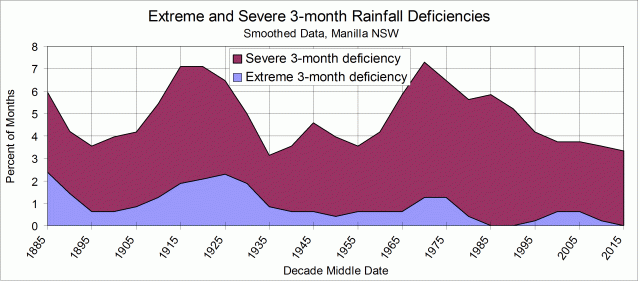This is the first of four graphs that show Manilla’s history of rainfall deficiencies (rainfall droughts), for periods of duration 3 months, 12 months, 36 months, and 120 months.
This first graph includes those short periods of severe or extreme rainfall deficiency that last only three months. They are rainfall droughts for one season rather than for a year or more. Crops and pastures may fail.
In Manilla’s climate, a time of severe 3-month rainfall deficiency has a rainfall total less than 50 mm, when it normally would be 150 mm.
The graph shows that such short-term droughts have occurred in every decade, but more often in some than in others. These brief droughts were most common (in 7% of months) around 1915, 1920 and 1970. They were least common (in only 3% of months) around 1895, 1935, 1940, 1955, and (more recently) in the twenty years since 1995.
Extreme short-term droughts (3-month total less than 26 mm) were more common near those times when severe short-term droughts were more common.
Areas shown on the graph
Rainfall deficiencies are called “severe” when they are lower than are recorded for five percent of the months. I have called deficiencies “extreme” when they are lower than are recorded for one percent of the months.
In this graph, I have coloured extreme deficiencies in blue. The maroon colour is deficiencies that are severe, but not extreme. The top edge of the maroon area marks the proportion of severe deficiencies including extreme deficiencies. As an average, this line is at five percent.
Data analysis
I have described the data and the method in “Notes” to my post “Manilla’s Record of Droughts”, of 25 November 2014.
More readable graphs
In my post “Extreme Droughts by Decade at Manilla”, dated 23 December 2014, I graphed the occurrence of extreme rainfall droughts of different duration.
That graph suffers from a problem common in showing extreme events: they are so rare it is hard to see any pattern!
This time, I have used three “tricks” to improve the display:
- adding to the few extreme rainfall deficiency events the more numerous severe rainfall deficiency events, and displaying the two together;
- making the resolution finer by overlapping by five years the decades that are used for counting; and
- applying some smoothing ((1:2:1)/4).
At the beginning and end of the record, decades are incomplete. I have assumed that the rate of occurrence for the part-decade would continue for the full decade.
Rather than simply counting the rainfall deficiency events in each decade, I have expressed the result (on the y-axis) as a percentage occurrence. Since there are 120 months in a decade, the percentage is 5/6 of the count of months meeting the condition.

